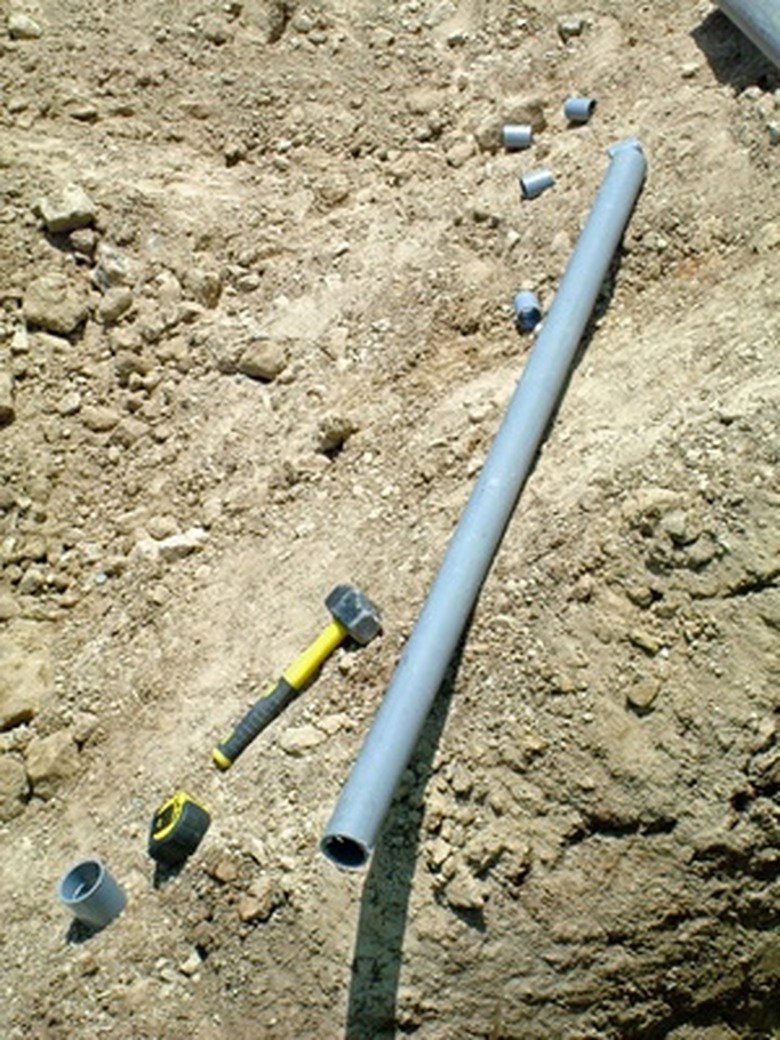How To Run Electrical Wire Outside
Things Needed
-
Drill
-
Masonry or wood drill bit
-
Schedule 40 PVC conduit
-
LB fitting
-
Outdoor rated silicone caulk
-
PVC glue
-
Trenching shovel
-
90-degree bend the PVC elbow
-
Hacksaw
-
PVC coupling
-
Underground feed direct burial cable (UF/DB)
-
Fish tape
You can run electrical wire outside to nearly any location. Although some types of electrical cable do not have to be enclosed in conduit for outside installation, enclosing any exposed cable is a good idea. Schedule 40 polyvinyl chloride (PVC) conduit for electricity is gray and is rated for sunlight resistance. The color also identifies it as electricity rather than a white waterline. With an enormous amount of PVC sizes and fittings, you can run electrical wire outside and up a tree should you choose to.
Step 1
Drill a hole through your structure where you will supply your power. Use a drill bit that will accommodate the size of the schedule 40 PVC conduit you choose to use as well as one that will drill through the material of your wall.
Step 2
Slide a short piece of schedule 40 PVC conduit through the structure's wall so that you can attach an LB fitting onto it. Use outdoor silicone caulking around the conduit at the structure in order to hold the conduit into place and keep water from going inside your structure. Make sure you have at least 1 inch of conduit exposed between the wall of your structure and the end of the conduit.
Step 3
Attach the LB fitting to the PVC conduit using PVC glue. An LB allows for a sharp 90-degree angle for turning corners with PVC. The back of the LB is removable to make wire pulling easier.
Step 4
Dig a trench 24 inches deep using a trenching shovel. Start digging against the structure and below the LB fitting. Continue to dig to where you are installing your electrical device. Most municipalities require that your trench be 18 to 24 inches deep. Check with your local municipality to verify the depth in which you will need to dig your trench; however, 24 inches should accommodate any municipality.
Step 5
Attach a piece of schedule 40 PVC conduit to the LB. Measure from the bottom of the LB to the bottom of your trench then delete 8 inches from the measurement to accommodate for a PVC elbow. Cut a piece of schedule 40 conduit with a hacksaw equal to your measurement.
Step 6
Attach the 90-degree bend PVC elbow to the PVC pipe. Use a coupling and PVC glue to attach the elbow and the pipe together. Attached the coupling to the elbow first and then attach the elbow to the PVC pipe.
Step 7
Pull your underground feed direct burial cable (UF/DB). Use a fish tape and, following the manufacturer's directions, pull the wire from your structure and through the conduit and into your trench.
Step 8
Lay your UF/DB cable in the trench and bury it. This cable is rated for sunlight and moisture resistance, so you can bury it directly underground without encasing it in conduit.
References
- HammerZone.com: Laying Conduit Between House And Garage
- James Dulley: Do-It-Yourself Weekend Project #107 "How to Install Outdoor Wiring"
- "Wiring 1-2-3": Steve Cory; 2005
